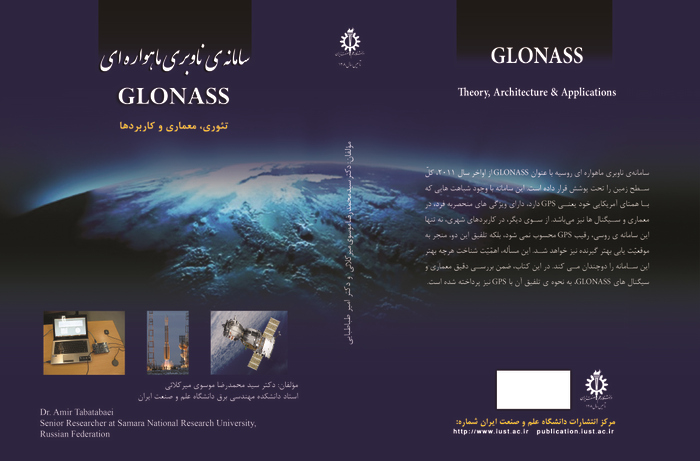The first book about GLONASS in Persian language has been published in Iran by Amir Tabatabaei. Dr. Amir Tabatabaei is senior researcher and invited lecturer at Samara National Research University, Russian Federation, and lecturer at Iran University of Science and Technology (IUST).
The publication of the book entitled “GLONASS: Theory, Architecture and Applications” is the result of research collaborations of GPS laboratory at Samara National Research University with Prof. M.R. Mosavi’s GNSS laboratory at IUST.
The publication of the book entitled “GLONASS: Theory, Architecture and Applications” is the result of research collaborations of GPS laboratory at Samara National Research University with Prof. M.R. Mosavi’s GNSS laboratory at IUST.
The book presents a complete and rigorous overview of the fundamentals, theories and applications of GLONASS.
The first Chapter of the book is a general description of GLONASS architecture and the comparison with other GNSS.
GLONASS signal structure is discussed in Chapter 2.
Then, the architecture of GLONASS software receiver including acquisition, tracking and navigation solution parts is studied in the 3rd Chapter. Some sample results with different data bases collected by a typical Front-End are also reported.
Navigation data modulated on the received signal and how to demodulate them are the subjects of Chapter 4.
Chapter 5 introduces a GLONASS vectorized receiver with the powerful features in urban canyons and harsh environments. The results of different experimental tests under hard conditions in Samara are also reported.
The integration of GPS and GLONASS in federated and vectorized architectures for increasing the reliability of the solutions is discussed in Chapter 6.
Finally, Chapter 7 describes the hardware and software platforms of the experimental tests throughout the book.

The first Chapter of the book is a general description of GLONASS architecture and the comparison with other GNSS.
GLONASS signal structure is discussed in Chapter 2.
Then, the architecture of GLONASS software receiver including acquisition, tracking and navigation solution parts is studied in the 3rd Chapter. Some sample results with different data bases collected by a typical Front-End are also reported.
Navigation data modulated on the received signal and how to demodulate them are the subjects of Chapter 4.
Chapter 5 introduces a GLONASS vectorized receiver with the powerful features in urban canyons and harsh environments. The results of different experimental tests under hard conditions in Samara are also reported.
The integration of GPS and GLONASS in federated and vectorized architectures for increasing the reliability of the solutions is discussed in Chapter 6.
Finally, Chapter 7 describes the hardware and software platforms of the experimental tests throughout the book.

 RU
RU  EN
EN  CN
CN  ES
ES 